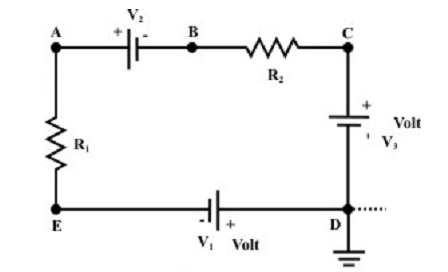Significance of Circuit Ground and the Voltages referenced to Ground
In electronic or electric circuits, generally maintain a reference voltage which is named “ground voltage” to which all voltages are referred. Such reference voltage is therefore at ground potential or zero potential and each other terminal voltage is measured with respect to the ground potential, a few terminals in the circuit will have voltages above it (i.e., positive) and some terminals in the circuit will have voltages below it (i.e., negative) or in the other words, some potential above or below ground potential or zero potential.
Consider the circuit as shown in figure below and the common point of connection of elements V1 & V3 and is chosen as ground (or reference) node. Whenever the voltages at various nodes are termed to this ground (or reference) point, we symbolize them with double subscripted voltages VED, VAD, VBD, and VCD. As the point is chosen as ground potential or zero potential, we can write down VED as VE, VAD as VA and so on.

Figure: A simple dc resistive circuit
In many situations, like in electronic circuits, the chassis is shorted to the earth itself for safety reasons.